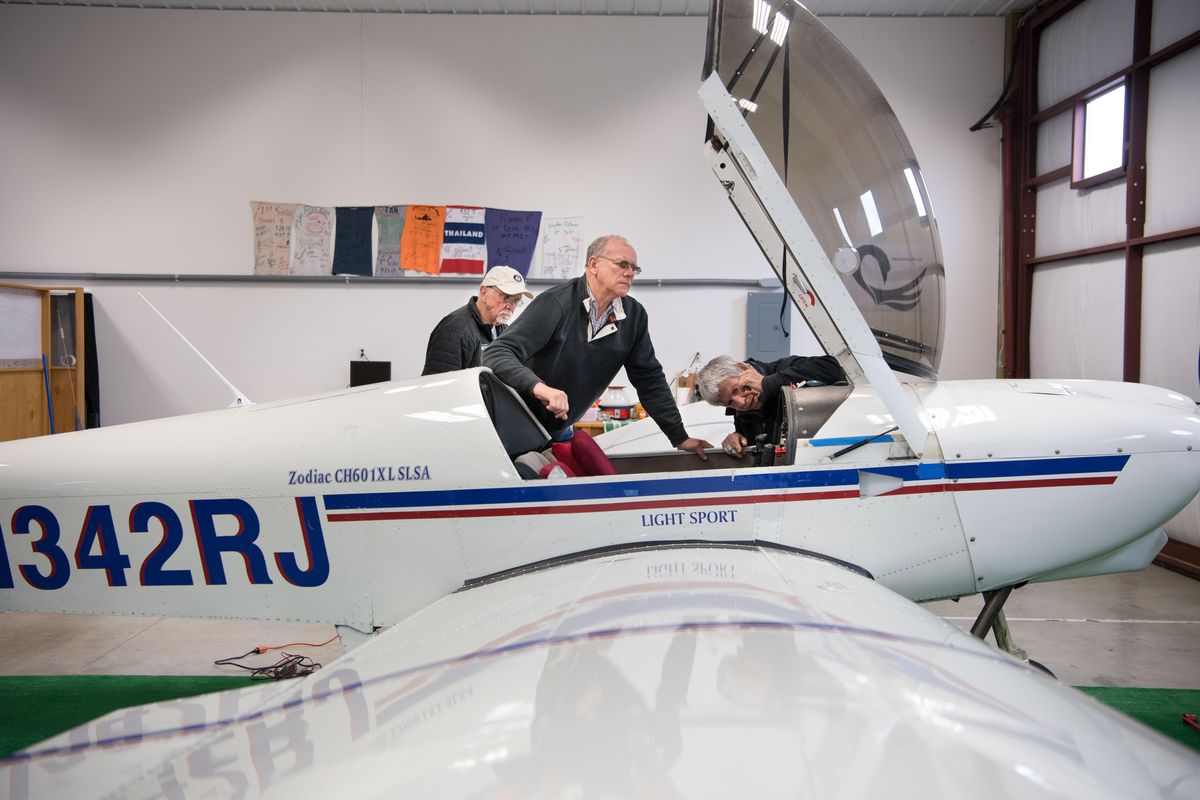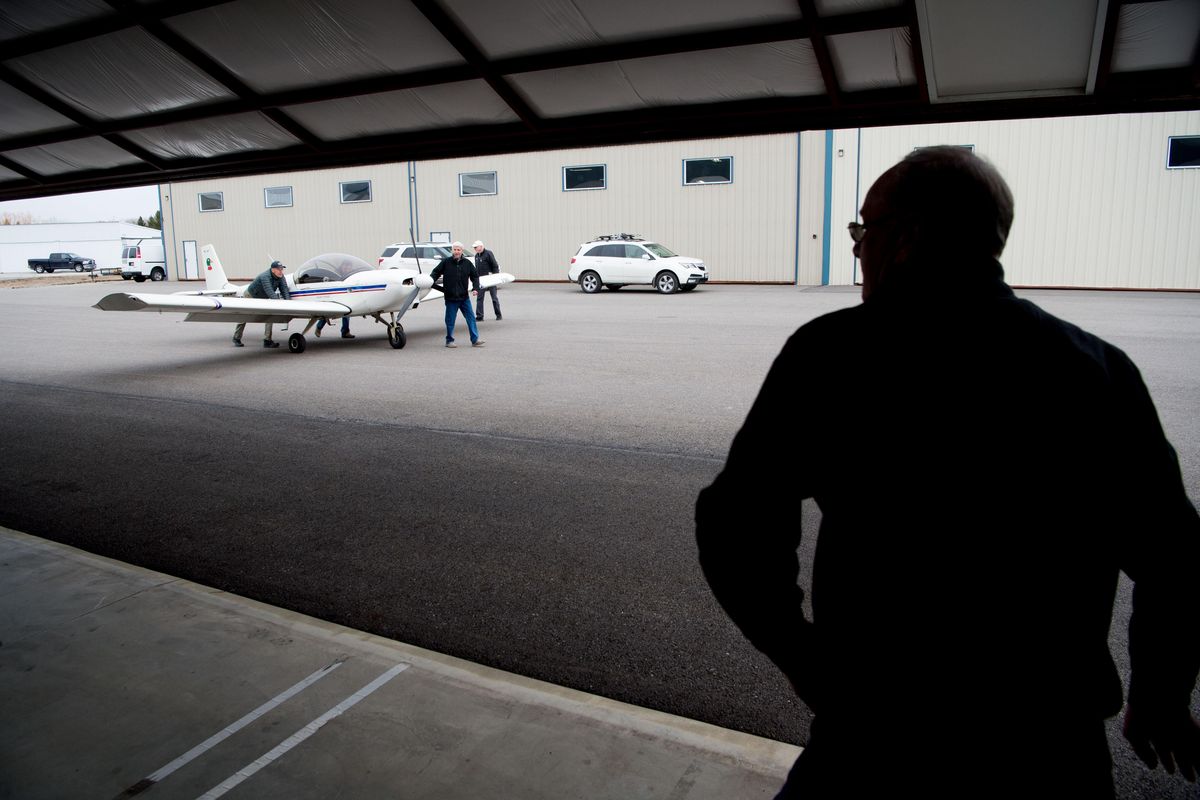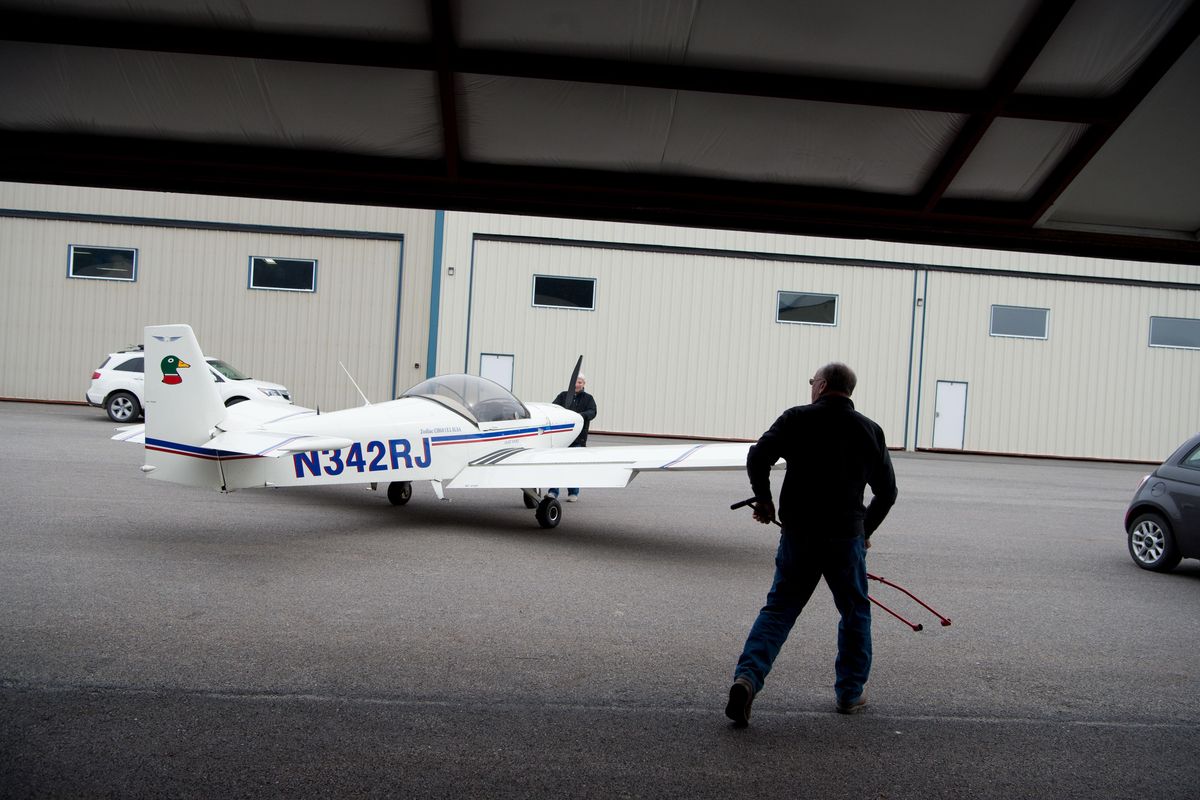Newport sees airport in its future
Ray King, the city administrator for Newport, Wash, right, opens a hanger door for his friend Ken Larson, a Gold Seal Flight Instructor, brings his airplane in on Tuesday, April 3, 2018, at the Sandpoint Airport in Sandpoint, Id. King is working to get the city of Newport to build an airport. (Tyler Tjomsland / The Spokesman-Review)Buy a print of this photo
NEWPORT – The small plane banked around craggy Chimney Rock, jutting above snow-covered mountains near Priest Lake. This was the fourth time Ray King had been flying in the remote mountains that week – living his dream.
The 65-year-old Newport city administrator flew out of Sandpoint’s airport that clear winter day, but, like all pilots, kept a checklist of nearby places to land, including all the small airfields in the region.
He is also aware that Newport is one of the few rural towns without one, something he hopes to change.
“One of the things you learn really quick: Always look for a place to put down,” King said.
Even though he just started flying a few years ago, he is no stranger to aircraft. He logged more than 5,000 hours in the air with the Air Refueling Wing of the Washington Air National Guard based at Fairchild Air Force Base. King also deployed for Desert Storm, Desert Shield and the conflict in Kosovo.
He wasn’t a pilot then but did almost everything during his military career, including aircraft maintenance and refueling boom operator.
“I enjoy it,” King said of recreational flying. “It’s a pretty close-knit group. A lot of neat people in it. The more you do it the more you get into it.”
The state and federal governments also recognize the need for a system of small airfields. It’s such an important priority that millions of dollars are spent annually to build and maintain them.
Small-airport funding shortage
There are 136 public-use airfields in Washington. A 2015 airport investment study determined that $3.6 billion over 20 years is necessary to keep up with infrastructure requirements and necessary improvements. Like other transportation infrastructure, the need is greater than the available funds.
A state bill signed into law last year increased the funding cap on a single state airport aid grant from $250,000 to $750,000. The higher cap will enable airports to apply for and complete larger, high-priority projects.
Another measure authorized the first Washington State Aviation specialty license plate. Revenues will support public-use airport infrastructure projects related to disaster response improvements, economic development and access enhancements, and infrastructure-related awareness programs.
“Rural airports are important to the Washington transportation system,” said David Fleckenstein, director of the Washington Department of Transportation’s aviation division.
“Airports in general are a gateway to communities,” he said. “Rural airports are uniquely important as they provide access to communities and enable services not readily available to rural communities without an airport.”
WSDOT’s Airport Aid Grant Program provides approximately $1.3 million per year to public-use airports across the state. This, along with local matching funds, brings in more than $75 million in federal grants.
Deer Park Airport tops list
The condition and management varies at these small airfields most people don’t even know exist.
They go from the grass strip near Sullivan Lake to Deer Park’s well-established 6,100-foot paved airstrip, which has a 20-year plan and annual funding to maintain and improve it.
Another pilot, Penni Loomis, 70, has been the driving force behind Deer Park’s airport.
She earned her private pilot’s license in 1989 but recently stopped flying. She directed the Deer Park airport for 23 years, retiring in 2014 after seeing it become what she called one of the best in the region.
There is a “trickle-down effect” on the local economy from having an airport, she said.
“This one is under so much demand right now it is phenomenal,” Loomis said.
When she started flying, she and her husband owned a small airplane based in Deer Park. The city was proceeding with a much-needed improvement plan on the airport, built in 1944.
She said the pilots wanted to have influence over the plans.
“The relationship was adversarial,” Loomis said. “People thought it was a rich people’s playground.”
The mayor at the time hinted that she should manage the airport, she recalled. So she did it as a volunteer. From that time on, it was a city airport but didn’t cost the city to operate.
She learned how to work with the federal government, including its system of funding through a program called the National Plan of Integrated Airport Systems.
It identifies about 3,400 existing and proposed airports that are significant to national air transportation and thus eligible to receive federal grants under the Airport Improvement Program. The Washington Department of Transportation’s aviation division and local governments also contribute.
The Idaho Department of Transportation, Division of Aeronautics also works with local airports on planning and funding. They also provide matching funds for these federal grants.
Deer Park developed a 20-year plan and netted about $12 million.
Every year, the list of small airports around the state shows millions of dollars being awarded for paving, design changes, navigation aids and fencing. Once in the system, money is provided annually for capital improvement projects in their plans.
“Always have to have a good place to take off and land,” Loomis said.
Gaining support is difficult
Loomis said Newport or any other small airport wouldn’t get community support by pointing out the recreational pilot use, although it is growing and important. The revenue sources and public uses at Deer Park Airport are more appealing to the general public and grant readers, she said.
“I don’t think that the selling point for establishing a new airport is just recreational use – you have to have economic reasons,” Loomis said.
There are no landing or takeoff fees at these airports, so they have to find other sources of operating funds.
For example, she said, they are now the summer base for federal and state forest fire aircraft and command staff. This brings in revenue for airport operations. They also sell aircraft fuel, an important revenue source.
Two flight-training businesses lease hangar space. They have 100 aircraft based there, with about 70 hangars.
One of many conditions of taking federal grants is that the airport can’t sell the land under hangars, only lease it.
Medical flights use the airport as do an increasing number of business jets, she said. Helicopters can’t always land at hospitals and other locations, so they need airports, she said. There are also fixed-wing medical service planes that land regularly.
Deer Park Airport has some unique revenue sources like selling timber from surrounding land. This has funded its capital improvement grant match.
The city also counts the airport as an advantage because it deposits treated sewage waste from nearby lagoons on the surrounding fields. It can also cause problems because it attracts deer and birds, Loomis said. They have installed wildlife fences using grant funds.
Law enforcement agencies and sports car clubs pay to use one runway for training, she said. Years ago they even leased the runways for drag races.
Rural airports are unique
“Every small airport has its own personality,” Loomis said. “Not a single one is the same.”
She has flown into most of them in the region and has been on advisory groups for some of them. She said they all face issues like encroachment from urban growth and funding shortfalls. How they have dealt with these has been the key to success or failure.
She noted Colville failed to take federal funds to study moving its airport from the current location near a hospital and school. Now it will be difficult to get more funding, she said.
Others have dealt with developers building fly-in homes along the runways, such as in Sandpoint, which is also discouraged by federal grant providers. Some, like Newport, closed their airports and will have trouble finding community support to get them back.
Newport airport’s first step
King is learning the challenges and techniques necessary to fly in the mountains in a taildragger plane preferred for landing on some of the short, unpaved airfields. He is also making contact with state aviation officials to learn how to develop an airport.
One of the classics is near Sullivan Lake on Forest Service land. The state runs airport under a federal permit.
Ione operates a paved runway at its airport, which has been the recipient of state and federal grants for decades.
Across the mountains is another grass airfield near Priest Lake, known for sled dog races and being a summer firefighting base. Priest River has an airport with a paved runaway and a long-range improvement plan.
These airfields exist throughout rural Washington and Idaho and are logged on maps, GPS and special phone apps.
They serve industry, research, law enforcement, firefighting and medical emergency needs of their communities.
Young people interested in flying
King only started flying small planes eight years ago. He has worked for Newport for 40 years, the last 17 as administrator.
In 2010, he started flying in a small plane with a friend. King said he decided to take flying lessons and eventually earned his private pilot’s license.
King recently proposed the city include an airport in its comprehensive plan.
Newport had an airport 30 years ago. It was located on city land that was sold to the Newport School District. Three schools are now located there along U.S. Highway 2.
After selling the land to the school district, city leaders promised the community they would build another. It never happened.
King has helped with the North Idaho High School Aerospace Program at the Sandpoint Airport for two years. He works with other volunteers and the students on weekends on their projects.
They built an experimental plane and are reconstructing from the ground up a 1945 Taylorcraft taildragger.
He said he has worked with several students who have gone on to study aviation in college, flight training school and military aviation careers.
King’s flying interests have extended to two of his three children. His son retired from flying in the military and became a UPS pilot based in Alaska. His daughter is now a nurse, but she had a 20-year career with the Air Refueling Wing of the Washington Air National Guard.
“The policy at work is if the opportunity presents to fly I jump on it,” King said.
But he adds that even if he retires from the city he will continue to work on improvement projects like building an airport.
“I believe Newport will have an airport. I’m committed to it,” he said.




